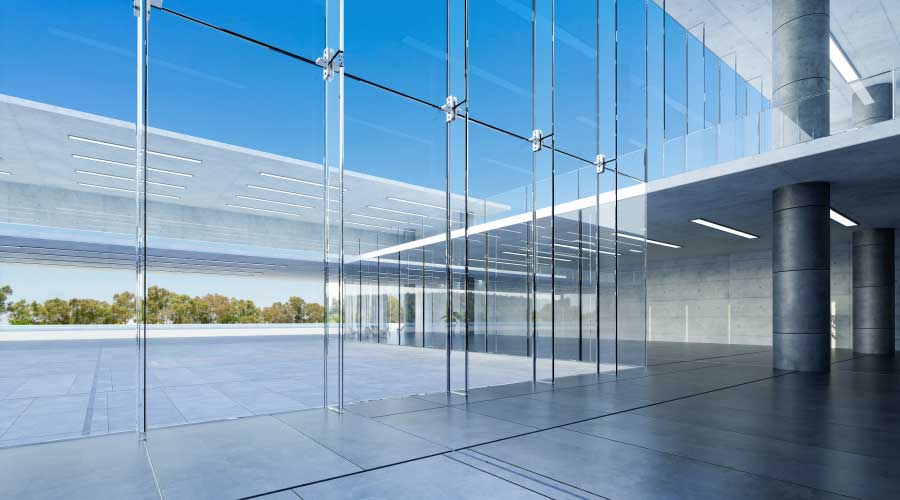For Efficient Exteriors, Start With the Outside, Looking In
Fenestration generally does not perform thermally as well as the opaque portions of the exterior cladding. Operable sash such as double hung or sliding windows that have operable joints can allow more uncontrolled air leakage than through the opaque, fixed cladding systems. The 2009 Edition of the ASHRAE Fundamentals Handbook rates the U-factor of a 1/8-inch-thick single pane glass at 1.04. The U-factor for a double glazed thermally broken aluminum window with one-half inch air space and a low-e coating on surface 2 is 0.53. Alternatively, commercially available triple glazed windows with argon gas have a U-factor of 0.14. Despite the difference in performance between what may exist in the building currently and the potential performance of new windows, the economic justification of window replacement can be controversial. Some calculations indicate that it can take over 50 years to realize a payback from window replacement based on energy savings alone. To achieve an earlier payback, the financial calculations for new windows could include reduced energy consumption due to reduced air leakage, reduced glare due to tinted window glazing and reduced maintenance costs due to the use of high performance coatings. While they are not included in the calculation, aesthetics also enter into the decision process. That's because older windows may give a building a dated appearance.
Before replacement windows are selected, the relative benefits of alternate repair options should be considered. Repairs to the existing weather stripping, replacement of perimeter and glazing sealant, the addition of a second layer of glazing, or the application of films should be considered. Due to their relative lower cost to implement and their targeted improvement that is directed at the poorest performing element of the window component, the ROI of repairs can be much higher than that of total window removal and replacement. This option can also be more environmentally acceptable.
Dating A Building
One benefit that window repairs do not provide is an improvement to the building's overall aesthetics. Windows are significant components in the building's façade and their appearance can date a building. Similarly, their replacement can quickly update a building's image and improve occupant satisfaction. The move from single-glazed, non-thermally broken windows or windows with poorly gasketed operable joints can be dramatic. Depending on the condition of the existing windows, the benefits of window replacement can include improved property values, reduced glare, reduced energy bills, reduced drafts, reduced water leakage, improved operation and reduced maintenance.
In some instances, if the existing cladding is sufficiently deteriorated and poorly performing, it can justify overcladding or its removal and replacement. While this type of work can be more disruptive to the building's occupants and operation, this work can have a more dramatic effect on the building's function and appearance.
Overcladding — the installation of a second cladding system over all or part of the existing system — can be done for aesthetic reasons, or to improve the performance of the exterior cladding in terms of thermal, water leakage, or acoustics. The resulting space between the two cladding systems may be available for pre-heating or cooling exterior air.
Overcladding can be performed if the existing structure has sufficient capacity to accommodate the additional loading that will be imposed by the additional materials. The advantages of overcladding can include reduced intrusion to the interior since a significant portion of the existing cladding remains along with the interior finishes. This can significantly reduce the project's cost because removal and replacement of the interior finishes may not be required, thus reducing disruption to the building's occupants. Similarly, cost savings can be realized. That's because some of the existing exterior cladding will not need to be removed and placed in a landfill. Overcladding can also reduce operating costs
If overcladding or re-cladding options are chosen, the inclusion of shading, or other sun control devices should be considered. Additionally, pre-heating or passive energy gains should be considered through the cavity that can be created between the existing cladding and the new overcladding.
While there are numerous options available to building owners for the improvement of their facilities, not all of them may be appropriate for every building. Although the decision process may seem initially overwhelming, it can be justified through a systematic process of identifying opportunities, evaluating existing performance levels, and determining what type of return on investment is required.
David F. Cook serves as a principal architect in structural and architectural evaluation, as well as a co-chair for the green solutions practice group, at CTLGroup. He is a registered architect with more than 30 years of experience in construction, project design, structural evaluation and project management. He can be reached at DCook@CTLGroup.com.
Related Topics:











